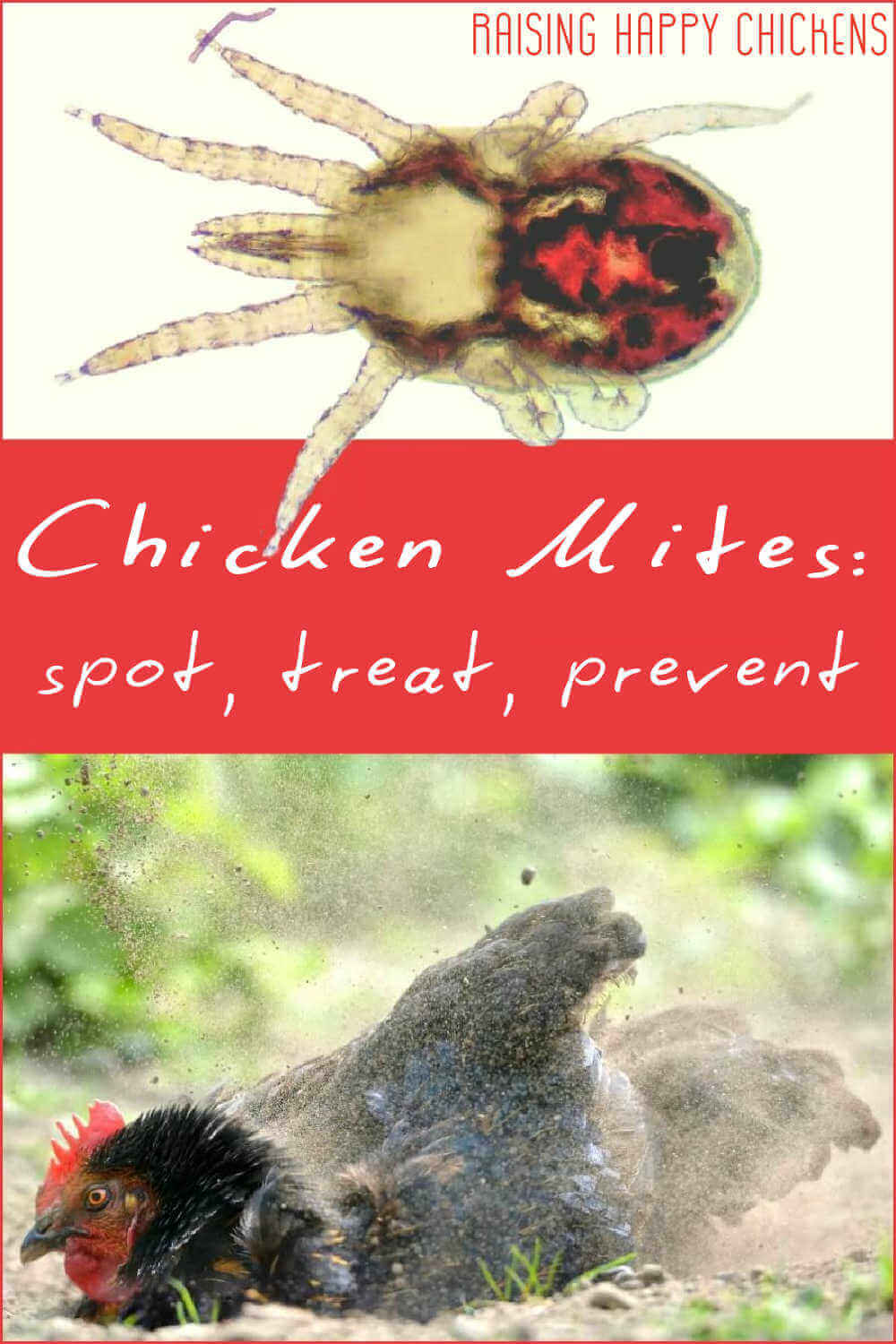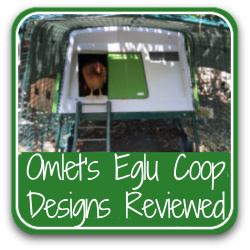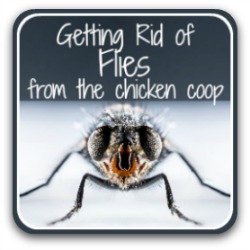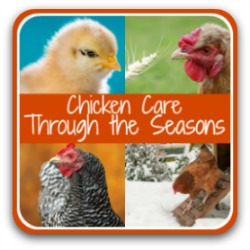- Home
- Challenges
- Mites
Chicken mites: how to spot, treat and prevent infestations.
Worried your chickens might have mites? They need relief – and you need guidance so you can provide it!
Chicken mites can become a real problem for your flock at any time of year.
In this article you'll find all you need to know: what they look like, where they come from, how they affect your chickens, how to tell you've got them, how to get rid of them, and how to prevent them in the first place.
Introduction: what are chicken mites and what do they look like?
Their scientific name is 'Dermanyssus Gallinae' but they're more commonly known as "red chicken mites" or the "red poultry mite".
- They're parasites which live on the outside of chickens and feed off their blood.
- Before they feed, they're light grey in colour. Once they've fed and they're full of blood they turn red.
- They feed at night when your flock has roosted, so your chickens' feet, legs, breast and vent are particularly vulnerable.
- Once daylight comes they leave the chicken and hide in crevices and cracks, only to come out to feed again once darkness falls.
This is a massively enlarged image of what they look like. In reality they're microscopic – like tiny, moving, red dots.
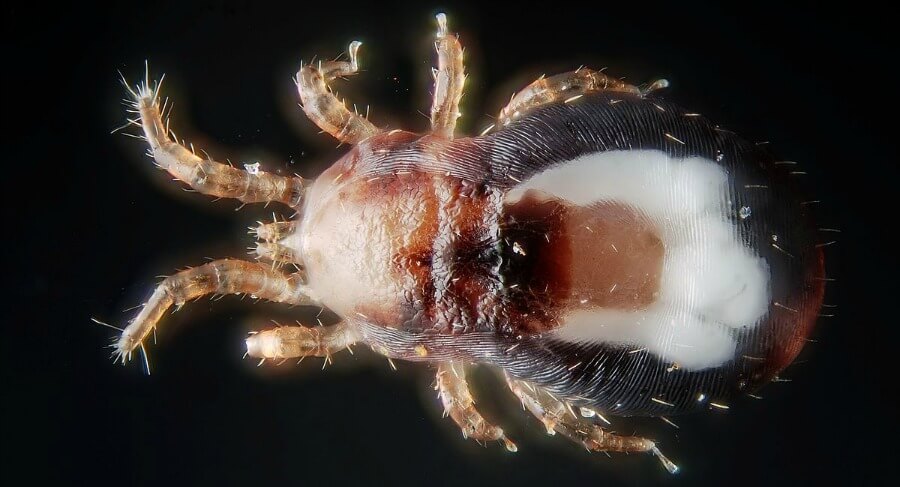 Chicken mite picture courtesy of Gilles San Martin of Namur, Belgium. Uploaded by Jacopo Werther.
Chicken mite picture courtesy of Gilles San Martin of Namur, Belgium. Uploaded by Jacopo Werther.- Although they feed off chickens' blood, they can survive without it for as long as seven months.
- That's why it's critical to make sure all bedding is burned and t re-used if you discover you have an infestation.
Identifying the problem: how do you know you've got mites?
There are two ways to assess whether you have red mites: by examining your chickens and by examining their coop.
Identifying red mites on chickens.
Mites are tiny. You may not even know you've got them. So, how can you tell?
The most obvious way is to look for symptoms in your chickens. These can include some or all of the following:
- Blood smears on legs
- Scabs on legs and feet
- Pale comb and wattles
- Loss of feathers
- Fewer eggs than usual
- Reluctance to roost
- The most obvious sign, though, is when you examine your chickens individually. Look for clumps of mites and eggs, particularly around the base of the feathers under the wings and around the vent.
- The best time to examine your chickens is at night, as that's when mites feed.
- Before the mites feed, they look like tiny grey insects; once they've gorged themselves on your chickens' blood they turn bright red.
Identifying chicken mites in the coop.
- To be sure red mites are definitely what you're dealing with, go into your coop at night with a torch and a piece of white paper.
- Check along the roosts. If you have a large number, you may be able to see them.
- Rub the paper along the bottom of the roosts, and at the end where the roost meets the wall. Does it have red smears? If it does, it's confirmed: you have red chicken mite.
- If you have a wooden coop, you're likely to find mites in other small cracks.
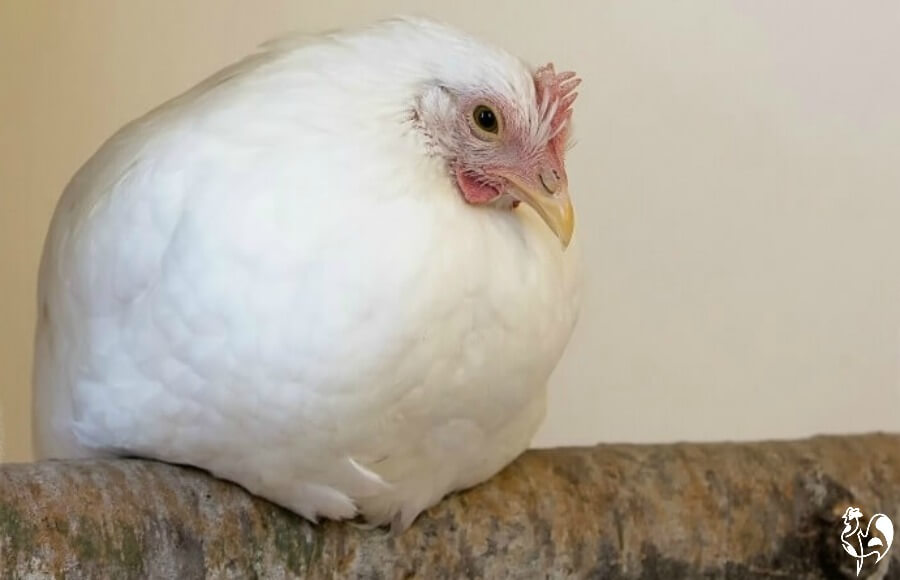 Red mites can often be found on roosting perches at night.
Red mites can often be found on roosting perches at night.Causes and effects of red mites on chickens.
Causes.
- The main source is wild birds, particularly pigeons(1, 2). Even a few mites left behind by wild birds visiting your chicken run will quickly multiply and become an infestation.
Effects.
- Effects on chickens range from mild to fatal, depending on how quickly they are discovered.
- Mites suck blood, mainly at night, and will also feed on skin and feathers(3). If left, the chicken will become weaker and likely to suffer from other illnesses because of a depleted immune system. In extreme circumstances, s/he may die.
- After feeding, the mites will leave the chicken and return to their safe place – often in cracks and crevices in the coop, and under or at the end of roosting bars.
Do chicken mites affect humans?
- Yes, but usually not during the day because they feed at night.
- If you go into an infested coop at night you're likely to be bitten. Their bites can cause irritation and itchiness, and can result in small red sores(3).
- Although they will bite humans, chicken mites don't infest them. The worst you'll experience is irritating bites, not unlike a mosquito or midge bite. Use an after-bite treatment to soothe the irritation.
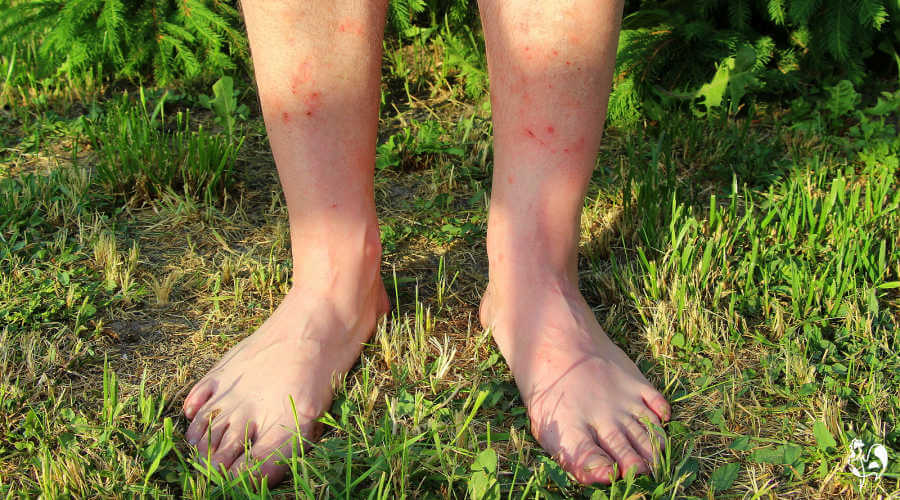 Chicken mites bites – not unlike a mosquito or midge bite.
Chicken mites bites – not unlike a mosquito or midge bite.Treatment: is leaving them alone an option?
No!
If not dealt with, a few mites can turn into an infestation. And that can lead to death, because the chickens become anaemic and prone to infection.
Even if you find them before they have a chance to reproduce much, they'll be causing your chickens pain. Imagine being trapped in a small room with mosquitoes biting at you, and being able to do nothing to escape.
So if you have any suspicion at all that you have red mite, make sure you don't ignore it. It's not nice to have to deal with it, but better that than cause your chickens pain and possible illness.
Treatment: where to start.
Important note:
Despite what you may read on the internet, please do not, ever, use motor oil (used or otherwise) on your chickens to get rid of mites.
You will do them far more harm than good. Motor oil burns the skin.
Firstly, whether you're going to use chemicals or not, there are steps you need to go through to prepare for treatment.
- Remove your chickens from the coop. Don't try to treat it when they're around.
- Now take everything out of the coop - and I do mean everything - and clean it. Bedding, roosts, feed, nest boxes and bedding, feed bins, any containers or implements - everything.
- Mites are ace at finding places to hide, and everything must be meticulously cleaned if you're going to be rid of them. An organic product is available (see this section), or use a liquid version of the chemicals in this section.
- Burn the bedding and, once you've treated the entire coop, replace with fresh. If you don't burn it you run the risk of never getting rid because there will be eggs and larvae as well as the mites themselves.
- Don't put bedding back down that's been stored in the coop - bales of straw, for example. Buy completely new, and burn everything else.
 No matter how comfortable your flock might look, if you have mites ALL bedding must be burned.
No matter how comfortable your flock might look, if you have mites ALL bedding must be burned.If you purchase a product through links in the following sections, I receive a small commission at no extra cost to you. I only recommend products I have purchased or would purchase myself and which I believe would benefit you. To learn more please see my disclosure policy.
Treatment: natural and organic methods.
Fire.
You'll see some information around the internet suggesting the only 'natural' way to get rid of chicken mites is to burn them with a blow-torch.
I don't recommend this. Why not? Because fire and chicken coops just don't go together. A wooden coop and roosts, flammable bedding, and flames aren't a good combination. Fire can spread very quickly, and with tragic results.
Predator mites.
This involves introducing a second mite into your coop which feeds on the red mite.
I haven't used this personally, but there's a great article at this link by my friend and expert poultry keeper Tim Daniels, who has used it with success.
Food Grade Diatomaceous Earth (DE).
Tiny particles of fossilised remains with very sharp edges cut and dehydrate the insects.
Views about DE vary wildly, from some who say it's bad for the respiratory tract in chickens (and humans), to others who claim it works marvels for all kinds of poultry problems.
The reality is somewhere in the middle. Used sparingly around the coop where mites collect, and in dusting hens suffering from mites, it can be very effective.
For more information see my detailed article which explores the risks and benefits - and always wear a mask when using it.
Poultry Shield.
Poultry Shield is only available in the UK in its liquid form. This is an organic, non-toxic product which is very effective at getting rid of mites from coops. Use it regularly for prevention, too.
In the US, although it's not possible to buy the liquid version, you can order its powder form for importation from the UK.
Wood ash.
Yep - plain old ash from a wood fire. But do not use ash from a fire which has burned treated wood, or any other substance - it must be pure wood ash.
Some people swear by dusting chickens thoroughly with this in case of an infestation. The easiest way is to put it in a bowl or bucket and rub it into the feathers, particularly under the wings and around the vent.
A note of caution: If you're using this, make sure it is bone dry. Wet wood ash is caustic and will burn your chickens' skin.
Herbs.
If you already have an infestation, herbs will not get rid of mites.
As with an infestation of rats, you might have to bite the bullet and use an insecticide first – and then opt for prevention methods by herbs.
The French marigold, tagetes patula, contains pyrethrum which is toxic to insects. See this article for more details.
Pennyworth and peppermint are also both natural repellents. Use them dried, and sprinkled in your chickens' dust-bath and coop.
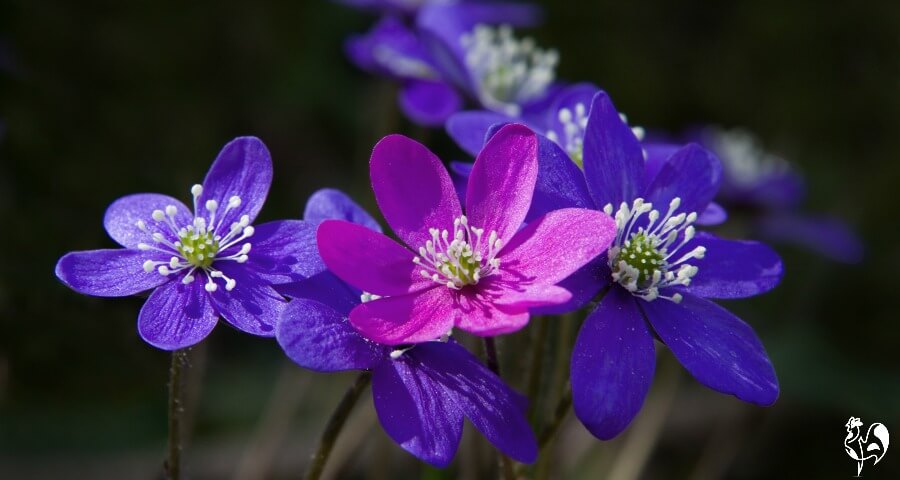 The pretty Pennyworth can be an effective mite repellent.
The pretty Pennyworth can be an effective mite repellent.Chemical treatments.
I like to try natural methods of pest control wherever possible – whether it's with a rat infestation, or these pesky insects.
But because they are so adept at survival, mites are notoriously hard to get rid of. So sometimes chemicals are the only answer.
If the infestation is really bad, you may have no choice but to use a chemical powder to get the insects under control. You'll then be able to follow it up with the gentler, more natural methods of prevention described above.
Make no mistake - these chemicals are poisons. Always take these precautions:
- Use protective gloves and a good mask. On no account breathe in the dust.
- Keep away from children and pets.
- Do not use outside on a windy day! Keep as much control as possible over the spread of these powders.
- Use away from areas where "good" garden insects like bees fly. Most are fatal to bees - it's one of the reasons the bee population is declining.
- Take note of the warnings on each product. Some are poisonous to cats, some to waterfowl.

- To apply, hold the chicken's wings away from its body and, whichever dust you're using, sprinkle it thoroughly underneath the wings and in the vent area.
- Do not sprinkle liberally over the chicken. In particular, avoid the head area.
- Even if only one chicken seems to have mites, you will need to treat the whole flock. It's likely that the others have latent eggs, which will hatch in a few days unless treated.
- Treatment must be carried out three times, with one week in between each treatment. This is to make sure all the larvae are killed, as well as the active mites.
Which chemicals?
Look out for these chemicals named on products available commercially. If you're at all worried about side effects, ask your veterinarian's advice.
Sevin dust.
I avoid using this because it's very toxic, and one of the worst killers of honey bees. There's no doubt, though, that it does get rid of mites.
If you use it, keep it well away from flowering plants where bees congregate.
Ivermectin.
Used in humans to get rid of scabies, head lice and bed bugs. It works by entering the bloodstream. When the bug bites, it ingests the drug and is poisoned.
It works in much the same way with chickens. It can have side effects, both on the chickens and on humans (which is why protective gloves and a mask should be worn - something like this one).
It's also toxic to waterfowl (so do not use it on ducks), some collie-type dogs, and kittens.
Be careful.
Permethrin.
This is the product I use if I need to get rid of a bad infestation. It's less toxic to mammals, apart from cats who are particularly susceptible to its toxicity, and fish.
So keep it away from your cats and any water sources or ponds.
Buy Permethrin safely from Amazon. (This is an "affiliate link", which means that if you click and buy something, I earn a small commission at no extra cost to you)
Prevention: how can you make sure you never have mites?
Prevention is always better than cure. There are a few fairly simple things you can do to make mites in the coop less likely.
- First and foremost: keep wild birds away from your chicken coop and run, as far as possible. You obviously can't keep them all away, but remove things like bird baths and feeders.
- If you have a wooden chicken house, consider investing instead in a smooth plastic coop. Mites simply cannot find anywhere to hide which hasn't got handy cracks and crevices! Take a look at my review of the Eglu coop. It's not cheap, but it's certainly worth the cost. I have two of these coops and have had no red mites since investing in them.
- Good husbandry: keeping your coop, roosts, nesting boxes and all tools clean will go a long way towards preventing the problem in the first place.
- Regular inspections of your flock's feathers, particularly under the wings and around the vent, will help stop mites really taking hold.
- Checking your coop, particularly underneath roosts and in cracks and crevices, can identify the problem before it becomes too bad. Remember: the best time to do this is at night.
- Providing dust baths for your flock is also critical. It's the way chickens keep themselves clean.
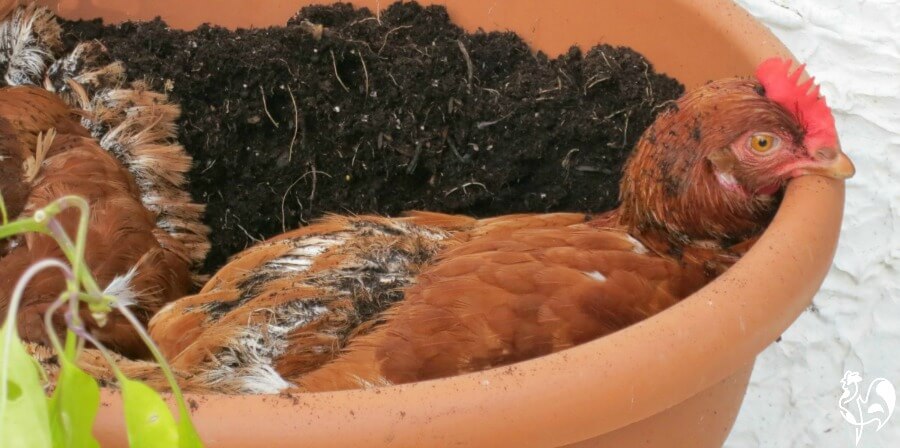 Claudia Chicken, who prefers to use my plantpots as a dust-bathing spa!
Claudia Chicken, who prefers to use my plantpots as a dust-bathing spa!- Quite often, they'll find their own favourite place for a dust bath (mine prefer my plantpots!) but in winter particularly, that's not as easy to do without your help.
- A container (my largest one is the hard plastic lid of a child's paddling-pool) with a good quality construction sand is ideal.
- My chickens actually prefer potting compost, and many people use wood ash – but, as I said above, if using wood ash make sure it is completely dry. If it gets wet it becomes caustic and will burn your poor chickens' skin.
- Adding herbs to your coop and to dust baths won't hurt, may help – and will certainly smell nice! Try dried marigold petals which are a natural insecticide, or dried lavender – very relaxing for your laying hens!
- You can read more about using natural ingredients in my free downloadable book, "Raising Healthy Chickens", if you don't already have it.
Frequently Asked Questions about chicken mites.
Can my dog be affected by chicken mites?
Can my dog be affected by chicken mites?
Yes, both cats and dogs can pick up red mites if they've been anywhere near chickens, or their coop, where mites are or have been a problem.
Remember: mites can live for a long time without chickens, so even if your coop is empty there may still be mites there.
The answer is to thoroughly clean the coop and the chickens, as described in my article.
To treat the dog you could try food grade Diatomaceous Earth, but seek advice from your veterinarian first.
Can chicken mites infect my home?
Can chicken mites infect my home?
Yes. If you carry mites from an infected coop on your shoes or clothing, they can set up home wherever there is blood to be sucked.
They can't live on humans in the long-term, but they can cause a lot of irritation while they do. The best way to avoid this is to wear protective clothing if you have a red mite infestation in your coop, and take it off before entering the house.
If you have a red mite infestation in your home you may need to call in a professional pest controller.
What seasons are poultry mite more active?
What seasons are poultry mite more active?
Because mites are introduced by wild birds, they can become a problem at any time of year.
To avoid problems you should practice good biosecurity measures throughout the year, and minimise the chance of wild birds getting into the run or coop.
Related articles to help control infestations of any kind.
Sources and further reading.
A lot of "facts" you'll find on the internet are often people's individual views, based on inaccurate information repeated from poor quality sources.
The information I provide in this article and others is based not just on my own experience, but on evidenced facts from scientific, peer-reviewed research and books from highly respected and experienced poultry keepers such as Gail Damerow.
Some of the trusted sources I have used in this article are these.
1. Haag-Wackermagel, D, and Bircher, A: Ectoparasites from feral pigeons affecting humans. Pub. Journal of Dermatology, 2009.
2. Townsend, Lee: External Mite and Insect Parasites of Backyard Chickens. Pub. University of Kentucky College of Agriculture (undated).
3. McCrea, B., et al: Common lice and mites of poultry - identification and treatment. Pub. University of California, Division of Agriculture and Natural Resources, 2005.
4. Damerow, Gail: 'The Chicken Health Handbook' (2nd edition). Pub. Storey Publishing, LLC, 2015.
Please note: This page is written as general information only. It is not intended as medical or veterinary advice and should not be taken as such.
If you're worried about your chickens' health, you should always see your veterinarian.
- Home
- Challenges
- Mites
